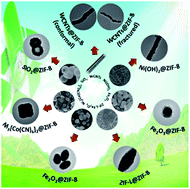A general strategy for coating metal–organic frameworks on diverse components and architectures†
Abstract
Forming a uniform metal–organic framework (MOF) nanocoating is still a famed challenge in the construction of core@shell composites. Here, a facile and versatile strategy that enables a surfactant-modified core to be wrapped up by a compact ZIF-8 shell has been reported. There is no limitation of the composition, dimension, size and shape of the core components, which can be CNTs, metal/non-metal oxides, organics and MOFs with dimensions ranging from one-dimensional (1D) nanowires to three-dimensional (3D) hollow spheres, and sizes from dozens of nanometers to several micrometers. The hybridization of various core components with a ZIF-8 shell offers the opportunity to achieve collective properties and create novel functions that are not available in individual building blocks. As a proof-of-concept application, the CNTs@ZIF-8 (Zn, Co) and Ni(OH)2@ZIF-8 (Zn, Co) derived CNTs@ZnCo2O4 and NiO@ZnCo2O4 composites manifest strong ability to improve the electrochemical performances as anode materials for lithium-ion batteries (LIBs). It is expected that the as-fabricated core@shell composites may cater to the various demands from applications in catalysis, sensing and energy storage.


 Please wait while we load your content...
Please wait while we load your content...